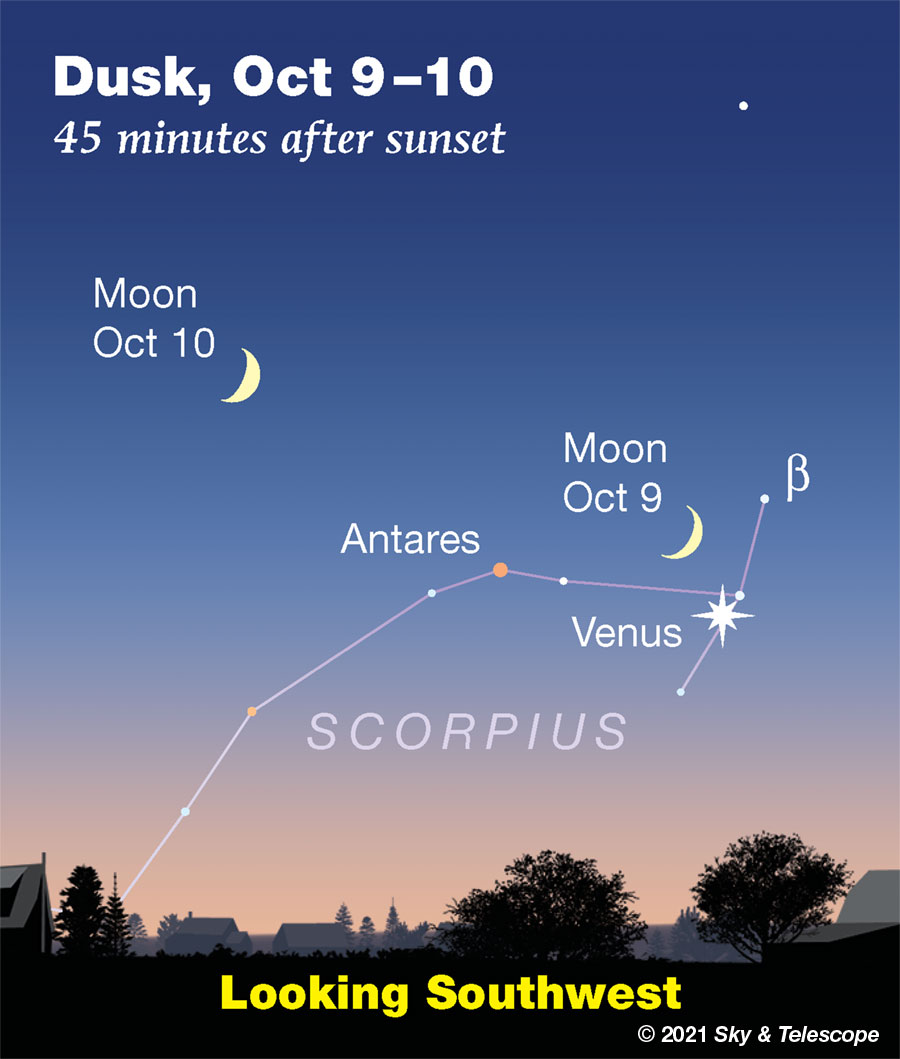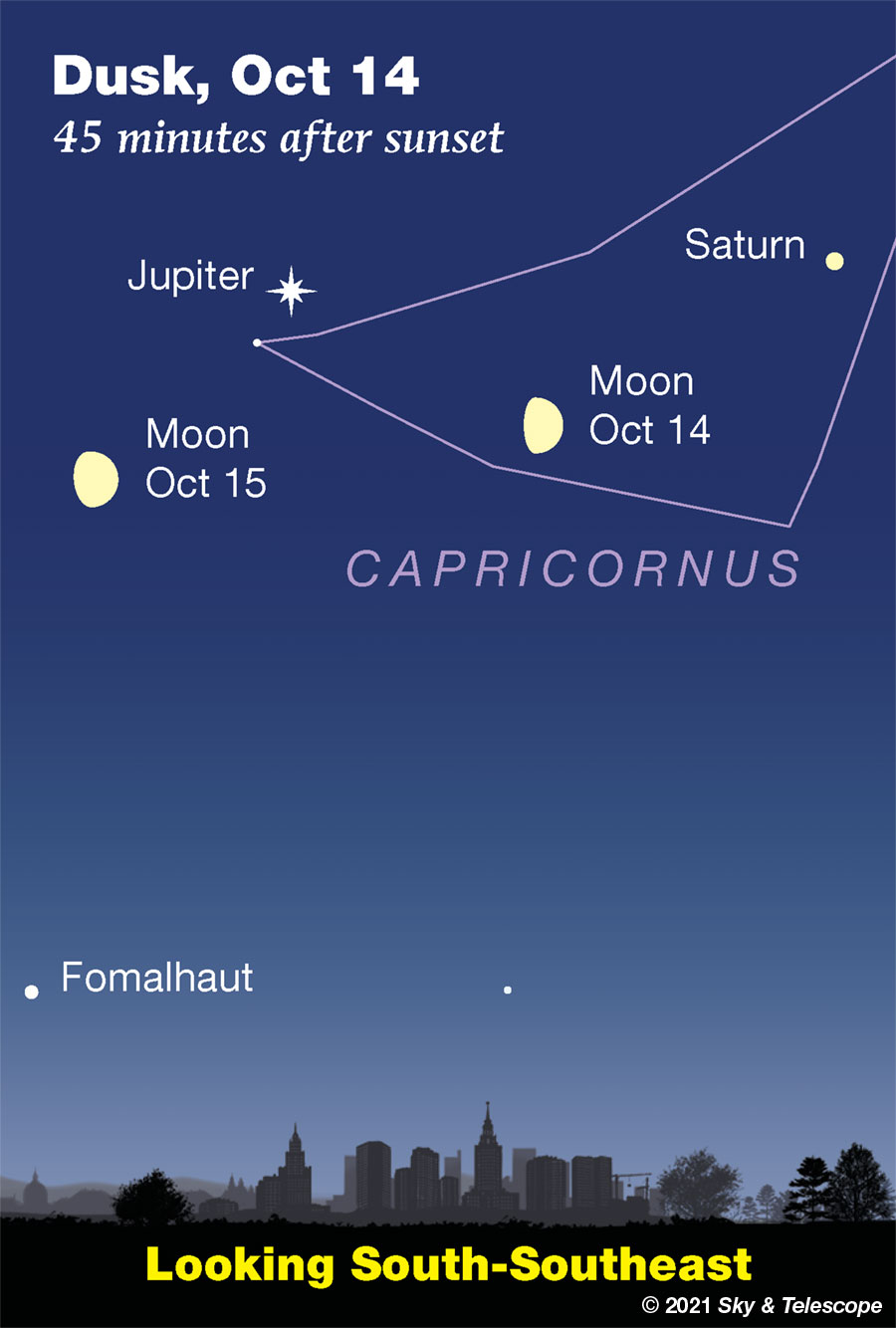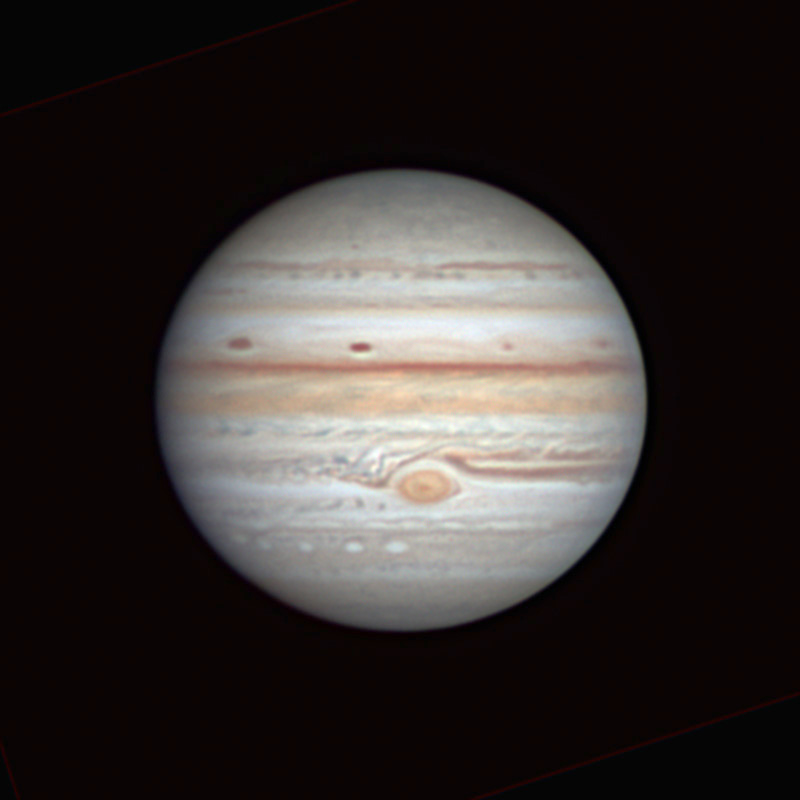Long-lasting, ever fluctuating Nova Cassiopeiae 2021 was about magnitude 7.4 as of October 8th. That's slightly brighter than when it exploded last March. Charts and comparison stars.
FRIDAY, OCTOBER 8
■ Bright Jupiter and fainter Saturn continue to dominate the southern evening sky this week. They're 15° apart.
■ This evening, spot Venus low in the southwest as early in twilight as you can. Then look lower right of it by some 12° (about a fist at arm's length) for the thin crescent Moon, 2½ days old. Binoculars help.
If you catch the ideal time window between the sky still being too bright and the Moon sinking too low, you should get a fine view of earthshine dimly lighting the Moon's nightlands inside the crescent. And the Moon is at perigee today, so it will appear just a little bit larger than average: a supercrescent moon.
You don't have photometric-quality eyes, but if you did, you might notice that earthshine on the Moon has gotten just a trace dimmer on average in recent years. This is due to a slow change in Earth's average reflectivity (albedo) over some 20 years due to changing cloudiness trends. The earthshine fade that P. R. Goode and colleagues measured across two decades from Big Bear Solar Observatory is tiny; it amounts to Earth absorbing an additional 0.5 watt per square meter of incoming sunlight on average. But they say this change matches measurements made by other methods and is "climatologically significant."
■ The very weak Draconid meteor shower should be at its peak around this date. But even under ideal dark-sky conditions it usually produces no more than 10 meteors visible per hour. . . and almost nobody's conditions are ideal.
But unlike most meteor showers, which perform best in the early-morning hours, the best time to watch for Draconids is in the evening, the sooner after dark the better. Why? The shower's radiant (in the head of Draco) starts the evening high in the northwest and wheels lower as the hours go by.
The meteors are bits of debris from Comet Giacobini-Zinner, so the shower is sometimes called the Giacobinids. In the past it has stormed spectacularly for a few hours or less, notably in 1933 and 1946 and to a lesser extent several times since, but don't expect that this year; the comet is not near us in its orbit.
■ Jupiter's Great Red Spot should cross Jupiter's central meridian around 10:41 p.m. EDT (7:41 p.m. PDT). The Red Spot remains closer to the central meridian than to the planet's edge for 50 minutes before and after it transits. A light blue or green filter at the eyepiece helps a bit.
SATURDAY, OCTOBER 9
■ Now the Moon shines only about 3° above Venus in twilight (for North America), just while Venus is passing ¾° lower left of 2nd-magnitude Delta Scorpii, as shown below. Bring binoculars!

SUNDAY, OCTOBER 10
■ Did you know that October is aurora season? Your chance of catching a display of the Northern Lights is greater now than average around the year, for reasons having to do with the tilt of Earth's magnetic axis with respect to the incoming solar wind and the shape of Earth's magnetosphere. This month the magnetosphere's northern "throat"is well aimed to swallow charged particles from the Sun and steer them down toward the world's north polar region. Sometimes a gust of particles widens the throat to include lands farther south. The mid-hours of the night are the likeliest time, and of course you want the Moon to have set by then. Keep an eye to the low north. See the October Sky & Telescope, page 48.
MONDAY, OCTOBER 11
■ Vega is the brightest star very high west of the zenith after dark. Less high in the south-southwest is Altair, not quite as bright. Just upper right of Altair, by a finger-width at arm's length, is little orange Tarazed. Down from Tarazed runs the dimmer stick-figure backbone of Aquila, the Eagle.
TUESDAY, OCTOBER 12
■ First-quarter Moon (exact at 11:25 p.m. EDT). The Moon shines just east (left) of the handle of the Sagittarius Teapot. Far to the Moon's upper left are Saturn and then Jupiter.
■ The Great Square of Pegasus balances on its corner high in the east during early evening. Away from the Great Square's left corner runs the main line of Andromeda, three 2nd-magnitude stars about as bright as those of the Square and spaced similarly far apart. (The three include the Square's corner.) This whole dipper-shaped pattern was named the Andromegasus Dipper by the late Sky & Telescope columnist George Lovi — joining the Big and Little Dippers, the Milk Dipper of Sagittarius (nowadays usually subsumed into the Teapot), and the tiny dipper pattern of the Pleiades.
WEDNESDAY, OCTOBER 13
■ With the season turning chill, Deneb has replaced Vega as the zenith star of early darkness (for skywatchers at mid-northern latitudes). Accordingly, Capricornus has replaced Sagittarius as the zodiacal constellation low in the south. This year, of course, Capricornus is overwhelmed by its two bright guests: Jupiter and Saturn.
■ Jupiter's Great Red Spot should transit the planet's central meridian around 9:49 p.m. EDT.
THURSDAY, OCTOBER 14
■ The Moon shines under Jupiter and Saturn, nearly equidistant from them as seen from the Americas in early evening; see the scene below. It's as if the Moon is swinging in a hammock that's tied to Jupiter and Saturn at its ends. Much fainter in the background is the hammock shape of Capricornus, larger than the bright one and askew to it.

FRIDAY, OCTOBER 15
■ Spot Venus low in the west in twilight. Just lower left of it, by 1½° (about a finger width at arm's length), look for orange Antares. It's less than 1% as bright. Venus stays about this close to Antares for the next two days, but watch their orientation change.
SATURDAY, OCTOBER 16
■ This is the time of year when, soon after nightfall, W-shaped Cassiopeia stands on end halfway up the northeastern sky — and when, off to its left in the north, the dim Little Dipper extends directly leftward from Polaris.
This Week's Planet Roundup
Mercury emerges into dawn view at the end of this week. By about October 18th, look for it low above the east horizon about 50 minutes before sunrise. Don't confuse Mercury with Arcturus, which is barely above the northeast horizon (depending on your latitude) way off to Mercury's left.
Mercury is on its way up toward its best morning apparition of the year. Stay tuned.
Mars remains out of sight, barely past its October 7-8 conjunction with the Sun.
Venus, brilliant at magnitude –4.3, shines low in southwest during twilight, in upper Scorpius. It sets soon after twilight's end. Venus will pass 1.4° north of Antares on Saturday the 16th.
Jupiter and Saturn continue to shine in the south during evening, 15° apart on opposite sides of Capricornus. Jupiter is the eye-
In late twilight they shine equally high in the south-southeast. As evening progresses watch them tilt as they move to the right, with Saturn becoming the lower one. Saturn sets around 1 a.m. daylight-saving time, followed by Jupiter about an hour later.
After dark look 23° (two fists at arm's length) lower left of Jupiter for 1st-magnitude Fomalhaut.
Here's a beginner's telescopic guide to Jupiter.

Uranus (magnitude 5.7, in southern Aries) climbs high in the east by 11.
Neptune (magnitude 7.8, at the Aquarius-Pisces border) is already well up in the in the southeast by twilight's end.
All descriptions that relate to your horizon — including the words up, down, right, and left — are written for the world's mid-northern latitudes. Descriptions that also depend on longitude (mainly Moon positions) are for North America.
Eastern Daylight Time, EDT, is Universal Time minus 4 hours. Universal Time is also known as UT, UTC, GMT, or Z time. To become more expert about time systems than 99% of the people you'll ever meet, see our compact article Time and the Amateur Astronomer.
Want to become a better astronomer? Learn your way around the constellations. They're the key to locating everything fainter and deeper to hunt with binoculars or a telescope.
This is an outdoor nature hobby. For an easy-to-use constellation guide covering the whole evening sky, use the big monthly map in the center of each issue of Sky & Telescope, the essential magazine of astronomy.
Once you get a telescope, to put it to good use you'll need a detailed, large-scale sky atlas (set of charts). The basic standard is the Pocket Sky Atlas (in either the original or Jumbo Edition), which shows stars to magnitude 7.6.

Next up is the larger and deeper Sky Atlas 2000.0, plotting stars to magnitude 8.5; nearly three times as many. The next up, once you know your way around, are the even larger Interstellarum atlas (stars to magnitude 9.5) or Uranometria 2000.0 (stars to magnitude 9.75). And be sure to read How to Use a Star Chart with a Telescope.
You'll also want a good deep-sky guidebook, such as the big Night Sky Observer's Guide by Kepple and Sanner.
Can a computerized telescope replace charts? Not for beginners, I don't think, and not on mounts and tripods that are less than top-quality mechanically, meaning heavy and expensive. And as Terence Dickinson and Alan Dyer say in their Backyard Astronomer's Guide, "A full appreciation of the universe cannot come without developing the skills to find things in the sky and understanding how the sky works. This knowledge comes only by spending time under the stars with star maps in hand."
![]() Audio sky tour. Out under the evening sky with your
Audio sky tour. Out under the evening sky with your
earbuds in place, listen to Kelly Beatty's monthly
podcast tour of the heavens above. It's free.
"The dangers of not thinking clearly are much greater now than ever before. It's not that there's something new in our way of thinking, it's that credulous and confused thinking can be much more lethal in ways it was never before."
— Carl Sagan, 1996
"Facts are stubborn things."
— John Adams, 1770
 3
3









Comments
misha17
October 9, 2021 at 12:33 am
A couple of years ago, Bob King posted an article about trying to see Sirius in the daytime.
Link:
https://skyandtelescope.org/observing/how-to-see-sirius-in-the-daytime/
Most of the article was tips on viewing it in late March, when it was at its highest (and due South) just before Sunset. He did mention it might also be possible when Sirius was due South just at sunrise, which occurs in early October. One person replied it might be easier to try it in October, starting with viewing it in morning twilight and trying to keep track of it until sunrise occurred.
We might be just at, or just passed, the morning "window" but maybe folks can give it a try for the next week or so.
You must be logged in to post a comment.
New Jersey Eclipse Fan
October 9, 2021 at 8:42 pm
Were we not supposed to notice that Mars is listed before Venus in the Planet Roundup above?
You must be logged in to post a comment.
Rod
October 12, 2021 at 8:38 am
In Maryland, my last good views were 02-Oct, early morning skies looking at the Moon. Since then, clouds, light rain, clouds, and more clouds 🙂 Maybe this weekend with Moon past First Quarter, I could see some sky again 🙂 My notes show that 11-Oct in the evening, Saturn stopped its retrograde motion in Capricornus and now is slowly moving again eastward and towards Jupiter in Capricornus, as Jupiter continues retrograde, moving towards Saturn 🙂
You must be logged in to post a comment.
You must be logged in to post a comment.